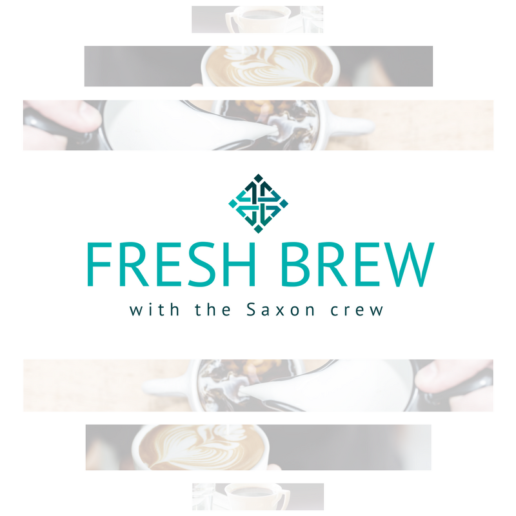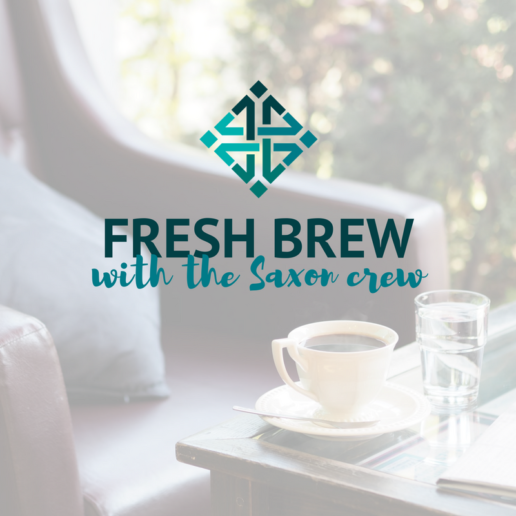Fresh Brew With Jake Meyer
Welcome to our monthly segment, Fresh Brew, where we will be exploring the delicious coffees, teas, and snacks of some of our employees! You can look forward to our Fresh Brew blog post on the first Friday of every month.
“Educate your employees about their benefits. The more they understand them, the more they will realize how big of a benefit they are.”
Jake Meyer is an Account Executive at Saxon Financial Services
Jake Meyer joined the Account Management team in December 2015 after previously working in operations for the Cincinnati Reds. He holds a B.A. Cum Laude in English Writing and Political Science, from the University of Pittsburgh.
Outside of the office, Jake enjoys spending time with his family and friends. He is an avid sports fan, and likes to attend sporting events as often as possible.


Rhinegeist Truth
Jake enjoys drinking Rhinegeist Truth which is a local Indian Pale Ale from the Rhinegeist Brewery in Cincinnati, Ohio.

Jake doesn’t have a particular favorite snack that he eats when sipping on his favorite brew. He instead likes to enjoy the hops in his favorite IPA.
Top Challenges for Managers in 2020
Technology and rising trends are creating new challenges for managers to handle. Different situations regarding employees from Generation Z and gig workers, mental health and vaping are creating new ways for managers to interact with employees. Read this blog post to learn more regarding how managers are facing these trials.
Managers in 2020 will face some new challenges, many having to do with their youngest workers. Among those challenges: leading employees from Generation Z and gig workers, addressing mental health issues and helping vapers kick the habit.
Understanding Generation Z
Generation Z workers—generally, those born in 1995 or later—should be on every manager's radar. "Within the next two or three years, they will become the fastest-growing percent of the workforce," said Jason Dorsey, a Generation Z researcher and co-founder of the Center for Generational Kinetics, a research and solutions company in Austin, Texas.
"They don't remember a time before smartphones or social media," he said. They live on their phones, not their laptops, and that's the way they want to communicate—on and off the job. "Gen Z expects to go through the entire application process on a mobile device."
Dorsey said managers often tell him that they don't remember young adults asking about retirement plans, but today's young workers do. "It's the aftershock of the Great Recession, when they saw their parents struggle," Dorsey said.
And Generation Z considers flexible scheduling to be a given, not a perk, Dorsey said. He advises managers who want to attract and retain young workers to offer not only flexible schedules but also flexibility on a start date and the ability to work remotely.
Finally, employees from Generation Z want to have access to their pay beyond the typical twice-a-month paycheck. Platforms such as Instant Financial, which allows workers to access a portion of their pay after every work shift, are appealing, Dorsey said.
Holding on to Generation Z employees may take some coaxing, said Cheryl Cran, founder of NextMapping, a future-of-work consultancy headquartered in Vancouver, British Columbia, Canada. "They are far more entrepreneurial than any other generation," she said, noting that many are gig workers by choice because they value their freedom. Hence, she said, "managers need to think about how to give them freedom" in a traditional job, whether that means offering remote work, flexible scheduling or another solution.
Understanding Gig-Worker Laws
An estimated 15 million adults in the U.S. have alternative work arrangements, according to the Bureau of Labor Statistics. However, concerns about whether employers should classify these workers as employees has spurred states to propose task forces or legislation, according to the National Conference of State Legislatures. Congress, meanwhile, is assessing H.R. 2474, Protecting the Right to Organize Act of 2019. The aim of these efforts is universal: to stop the exploitation of nonemployee workers.
But that goal can misfire, contend some gig workers who are worried about losing their livelihood. California's AB 5, which took effect Jan. 1 and requires businesses to reclassify many independent contractors as employees, has already triggered controversy, including lawsuits challenging it on constitutional and other grounds and pushback from independent journalists, photographers, interpreters, musicians, truckers and others the law doesn't exempt.
Many of these independent workers tend to be young adults who value the flexibility that comes with freelancing. But that flexibility can make traditional employees at the same company resentful. Inspiring teamwork will be no small task, said Alec Levenson, Ph.D., senior research scientist at the USC Marshall Center for Effective Organizations.
"We are at the tipping point of employers hiring people from all different [work] arrangements," he said. "There is not enough focus on productivity, how to get people to work together as a team."
Destigmatizing Mental Health Issues
Mental health disorders, according to the U.S. Centers for Disease Control and Prevention, are among the most burdensome health concerns in the workplace. Nearly 1 in 5 adults reported having some type of mental illness in 2017; stress symptoms, such as headaches or feeling overwhelmed or anxious, are also common.
Adults from Generation Z report the highest stress levels, according to the American Psychological Association's 2019 Stress in America survey. On a scale of 1 to 10, 10 being the highest level of stress, Generation Z reported an overall stress level of 5.8. Generation X averaged 5.5, Millennials 5.4 and Baby Boomers 4.2.
In a tight labor market, where there is stiff competition for talent, managers who show concern about their workers' mental health will stand out to applicants and existing employees, said LuAnn Heinen, vice president for well-being and productivity for the National Business Group on Health (NBGH), a nonprofit headquartered in Washington, D.C., that represents large employers' perspectives on health policy.
In a 2019 NBGH survey, 43 percent of managers said they had a formal mental health strategy in place, including strategies to address depression, anxiety and stress; opioid and other substance abuse; sleep disorders; and workplace bullying.
The managers said the most important components of those strategies are making employees aware of the importance of mental health; hosting mental health awareness events; and training managers on what mental health is, how to recognize trouble signs and how to refer workers to mental health resources.
Even the best mental health programs won't succeed, however, if people don't feel comfortable accessing them, Heinen pointed out. Managers who need help talking with workers about mental health issues can turn to programs such as MakeItOK.org.
Helping Vapers Quit
As of Jan. 7, 2020, a lung illness tied to vaping nicotine or products containing tetrahydrocannabinol, the chemical in marijuana responsible for the high, had resulted in 2,668 hospitalizations and 60 deaths. Employees who vape—many of them young adults—may need help to end their habit.
Programs to help people quit need to be tailored to the generation of workers you're targeting and that cohort's preferred communication style, Heinen said.
Truth Initiative, a nonprofit in Washington, D.C., devoted to eliminating tobacco use, has fine-tuned its decade-old digital tobacco-cessation platform developed with the Mayo Clinic. "We launched a program specifically to address the needs of vapers," said Amanda Graham, Ph.D., chief of innovations for Truth Initiative. The quit-vaping program uses text messages, preferred by many younger adults, and includes instant message support if users feel they are slipping.
SOURCE: Doheny, K. (06 February 2020) "Top Challenges for Managers in 2020" (Web Blog Post). Retrieved from https://www.shrm.org/ResourcesAndTools/hr-topics/people-managers/Pages/Top-Challenges-for-Managers-in-2020.aspx
Fresh Brew with Nat Gustafson
Welcome to our monthly segment, Fresh Brew, where we will be exploring the delicious coffees, teas, and snacks of some of our employees! You can look forward to our Fresh Brew blog post on the first Friday of every month.
“Always be prepared.”
Nat Gustafson is an Account Manager at Saxon Financial.
Nat began his career at Total Quality Logistics. For four months, he learned to control himself in hectic situations and to better manage his time. Most importantly, he taught himself how to effectively communicate with others in difficult situations.
In his free time, Nat enjoys snowboarding. When thinking about his greatest adventure, he remembers traveling around Italy. He lives by the catchphrase of, “Roll up your sleeves.”


Rhinegeist Truth
Nat enjoys a Rhinegeist Truth, an indian pale ale, from his favorite local spot, Mount Lookout Tavern on Linwood Avenue.

Chicken Wings
Nat enjoys sipping on his favorite brew while eating chicken wings from Mount Lookout Tavern.
The New Analytics of Workplace Culture
Workplace cultures vary significantly depending on the workplace itself. With new technology and various ways to analyze employees' viewpoints on their workplaces' culture, new ways are being implemented to analyze and measure cultures around different businesses. Read this blog post to learn more about different methods to process employees' thoughts behind their workplace culture.
A business's culture can catalyze or undermine success. Yet the tools available for measuring it—namely, employee surveys and questionnaires—have significant shortcomings. Employee self-reports are often unreliable. The values and beliefs that people say are important to them, for example, are often not reflected in how they actually behave. Moreover, surveys provide static, or at best episodic, snapshots of organizations that are constantly evolving. And they're limited by researchers' tendency to assume that distinctive and idiosyncratic cultures can be neatly categorized into a few common types.
Our research focuses on a new method for assessing and measuring organizational culture. We used big-data processing to mine the ubiquitous "digital traces" of culture in electronic communications, such as emails, Slack messages and Glassdoor reviews. By studying the language employees use in these communications, we can measure how culture actually influences their thoughts and behavior at work.
In one study, two of us partnered with a midsize technology company to assess the degree of cultural fit between employees and their colleagues on the basis of similarity of linguistic style expressed in internal email messages. In a separate study, two of us analyzed the content of Slack messages exchanged among members of nearly 120 software development teams. We examined the diversity of thoughts, ideas and meaning expressed by team members and then measured whether it was beneficial or detrimental to team performance. We also partnered with employer-review website Glassdoor to analyze how employees talk about their organizations' culture in anonymous reviews to examine the effects of cultural diversity on organizational efficiency and innovation.
The explosion of digital trace data such as emails and Slack communications—together with the availability of computational methods that are faster, cheaper and easier to use—has ushered in a new scientific approach to measuring culture. Our computational-lingustics approach is challenging prevailing assumptions in the field of people analytics and revealing novel insights about how managers can harness culture as a strategic resource. We believe that with appropriate measures to safeguard employee privacy and minimize algorithmic bias it holds great promise as a tool for managers grappling with culture issues in their firms.
The Studies
Our recent studies have focused on cultural fit versus adaptability, the pros and cons of fitting in, cognitive diversity and the effects of diversity on organizational performance. Let's look at each in detail.
Fit versus adaptability. When managers think about hiring for cultural fit, they focus almost exclusively on whether candidates reflect the values, norms and behaviors of the team or organization as it currently exists. They often fail to consider cultural adaptability—the ability to rapidly learn and conform to organizational cultural norms as they change over time. In a recent study two of us conducted with Stanford's V. Govind Manian and Christopher Potts, we analyzed how cultural fit and cultural adaptability affected individual performance at a high-tech company by comparing linguistic styles expressed in more than 10 million internal email messages exchanged over five years among 601 employees. For example, we looked at the extent to which an employee used swear words when communicating with colleagues who themselves cursed frequently or used personal pronouns ("we" or "I") that matched those used by her peer group. We also tracked how employees adapted to their peers' cultural conventions over time.
We found, as expected, that a high level of cultural fit led to more promotions, more-favorable performance evaluations, higher bonuses and fewer involuntary departures. Cultural adaptability, however, turned out to be even more important for success. Employees who could quickly adapt to cultural norms as they changed over time were more successful than employees who exhibited high cultural fit when first hired. These cultural "adapters" were better able to maintain fit when cultural norms changed or evolved, which is common in organizations operating in fast-moving, dynamic environments.
These results suggest that the process of cultural alignment does not end at the point of hire. Indeed, our study also found that employees followed distinct enculturation trajectories—at certain times in their tenure demonstrating more cultural fit with colleagues and at other times less. Most eventually adapted to the behavioral norms of their peers, and those who stayed at their company exhibited increasing cultural fit over time. Employees who were eventually terminated were those who had been unable to adapt to the culture. Employees who left voluntarily were the most fascinating: They quickly adapted culturally early in their tenures but drifted out of step later on and were likely to leave the firm once they became cultural outsiders.
To further assess how cultural fit and adaptability affect performance, Berkeley's Jennifer Chatman and Richard Lu and two of us surveyed employees at the same high-tech company to measure value congruence (the extent to which employees' core values and beliefs about a desirable workplace fit with their peers) and perceptual congruence (how well employees can read the "cultural code" by accurately reporting the values held by peers). We found that value congruence is predictive of retention—employees with it are less likely to voluntarily leave the company—but is unrelated to job performance. We found that the opposite is true of perceptual congruence: It is predictive of higher job performance but unrelated to retention. These results suggest that companies striving to foster a stable and committed workforce should focus on hiring candidates who share similar values with current employees. Employers needing people who can quickly assimilate and be productive should pay greater attention to candidates who demonstrate the ability to adapt to new cultural contexts.
The benefits of not fitting in. When might it better to hire a cultural misfit? People who see the world differently and have diverse ideas and perspectives often bring creativity and innovation to an organization. But because of their outsider status, they may struggle to have their ideas recognized by colleagues as legitimate. In a recent study two of us conducted with V. Govind Manian, Christopher Potts, and William Monroe, we compared employees' levels of cultural fit with the extent to which they served as a bridge between otherwise disconnected groups in the firm's internal communication network. For instance, an employee might have connections with colleagues that bridge both the engineering and sales departments, allowing her to access and pass on a greater variety of information and ideas.
Consistent with prior work, we found that cultural fit was, on average, positively associated with career success. The benefits of fitting in culturally were especially great for individuals who served as network bridges. When traversing the boundary between engineering and sales, for example, they could hold their own in technical banter with the former and in customer-oriented discourse with the latter. People who attempted to span boundaries but could not display cultural ambidexterity were especially penalized: They were seen as both cultural outsiders and social outsiders without clear membership in any particular social clique. However, we also identified a set of individuals who benefited from being cultural misfits: those who did not have networks spanning disparate groups but instead had strong connections within a defined social clique. By building trusting social bonds with colleagues, they were able to overcome their outsider status and leverage their distinctiveness. These results suggest that an effective hiring strategy should strive for a portfolio of both conformists—or at least those who can rapidly adapt to a company's changing culture—and cultural misfits.
Cognitive diversity. Proponents of cultural diversity in teams presume that it leads to cognitive diversity; that is, diversity in thoughts and ideas. But the findings about whether cognitive diversity helps or hinders team performance are inconclusive. Part of the problem is that these studies use imperfect proxies for cognitive diversity, such as diversity in demographics, personalities or self-reported beliefs and values. Moreover, this line of research has rarely looked at how diversity is actually expressed in communications and interactions, which is problematic given that team members are sometimes reluctant to share their real feelings and opinions. Finally, cognitive diversity is often assumed to be static, even though we know team dynamics frequently change over a project's life cycle.
In a new study, which two of us conducted with Stanford researchers Katharina Lix and Melissa Valentine, we overcame these challenges by analyzing the content of Slack messages exchanged among team members of 117 remote software-development teams. We identified instances when team members discussing similar topics used diverse meanings, perspectives and styles, and then analyzed the impact of that diversity on performance. For example, in discussions of customer requirements, different interpretations of the desired look and feel of the user interface in some cases led developers to talk past one another and fail to coordinate, but in other cases sparked creative new ideas.
Our results indicate that the performance consequences of cognitive diversity vary as a function of project milestone stages. In the early stages, when the team is defining the problem at hand, diversity lowers the chances of successfully meeting milestones. During middle stages, when the team is most likely to be engaged in ideation, diversity increases the likelihood of team success. Diversity becomes an obstacle again toward the end of a project, when the team is deep into execution.
Cultural diversity and the organization as a whole. We've seen that there are trade-offs associated with diversity in teams, but how does it affect the performance of entire organizations? Conventional wisdom holds that firms must choose between a homogeneous, efficient culture and a diverse, innovative culture. A homogeneous culture improves efficiency and coordination, the theory goes, because employees agree about the norms and beliefs guiding work, but the benefits come at the expense of fewer novel ideas about how to accomplish tasks. In contrast, a heterogeneous culture sacrifices the benefits of consensus in favor of healthy disagreement among employees that can promote adaptability and innovation. The evidence supporting this thinking, however, is scant and inconclusive.
In a recent study, we analyzed the language that employees used when describing their organization's culture (for example, "our culture is collaborative," "our culture is entrepreneurial," and so on) in anonymous reviews of nearly 500 publicly traded companies on Glassdoor. We first measured the level of interpersonal cultural diversity, or disagreement among employees about the norms and beliefs characterizing the organization. We found that interpersonal cultural diversity makes it difficult for employees to coordinate with one another and reduces the organization's efficiency as measured by return on assets.
We then measured the organizations' level of intrapersonal cultural diversity. Those with high intrapersonal cultural diversity had employees with a large number of cultural ideas and beliefs about how to accomplish tasks within the company (measured as the average number of cultural topics that employees discussed in their Glassdoor reviews). For instance, employees at Netflix conceptualized the work culture in terms of autonomy, responsibility, collaboration and intense internal competition. We found that organizations with greater intrapersonal cultural diversity had higher market valuations and produced more and higher-quality intellectual property via patenting, evidence that their employees' diverse ideas about how to do work led them to be more creative and innovative.
This suggests that organizations may be able to resolve the assumed trade-off between efficiency and innovation by encouraging diverse cultural ideas while fostering agreement among employees about the importance of a common set of organizational norms and beliefs. Again, consider Netflix: Although "multicultural" employees contributed to the company's diverse culture and drove innovation, the culture was nonetheless anchored by core shared beliefs, such as the importance of radical transparency and accountability, which help employees coordinate and work efficiently.
Implications for Practice
How can these findings inform leaders' understanding of culture as a tool for improving the performance of employees, teams and the broader organization?
First, managers can increase retention by hiring candidates whose core values and beliefs about a desirable workplace align well with those of current employees. However, too much emphasis on cultural fit can stifle diversity and cause managers to overlook promising candidates with unique perspectives. Hiring managers should look for candidates who demonstrate cultural adaptability, as these employees may be better able to adjust to the inevitable cultural changes that occur as organizations navigate increasingly dynamic markets and an evolving workforce.
Hiring managers should also not overlook cultural misfits. They can be wellsprings of creativity and innovation. But to make sure they flourish inside the organization, managers should consider assigning them to roles in which they are likely to develop strong connections within particular social groups. That's because misfits need the trust and support of colleagues to be seen as quirky innovators rather than outlandish outsiders.
Second, leaders should be mindful that the expression of diverse perspectives in teams needs to be managed. Cognitive diversity is essential for generating novel, innovative solutions to complex problems, especially during the planning and ideation phases of a project. However, the expression of diverse perspectives can quickly become a liability when the team needs to focus on execution and meet looming deadlines. It is during these times that team members have to unify around a common interpretation of the problem and come to agreement about what needs to get done to solve it. Leaders must be adept at switching back and forth, learning when and how to promote the expression of divergent opinions and meanings and when to create a context for convergence.
An important distinction is warranted here. The term "diversity" is often used to connote variation in the demographic makeup of a firm's workforce. This has been particularly the case in recent years, as companies have tackled pernicious problems such as the underrepresentation of women and minorities in decision-making positions in organizations. In our work, we use "cultural diversity" to refer to variation in people's beliefs and normative expectations, irrespective of their demographic composition. As we pointed out earlier, demographic and cultural diversity are related, but a demographically homogenous group may be culturally diverse, and vice versa. Our research on cultural diversity is relevant to but ultimately independent of efforts to increase gender, race and ethnic diversity in firms.
Third, leaders should foster a culture that is diverse yet consensual in order to promote both innovation and efficiency. Such a culture is composed of multicultural employees who each subscribe to a variety of norms and beliefs about how to do work. These diverse ideas help employees excel at complex tasks, such as dreaming up the next groundbreaking innovation. Managers should encourage employees to experiment with different ways of working—extensive collaboration for some tasks, for example, and intense competition for others. At the same time, a culture should also be consensual in that employees agree on a common set of cultural norms—shared understandings—that helps them successfully coordinate with one another. Leaders can signal the importance of these norms during onboarding and in everyday interactions, just as leaders at Netflix do by rewarding employees for sharing their mistakes with colleagues in order to promote beliefs about the value of transparency.
A New Management Tool
Many of the tools we used in these studies are off-the-shelf products, and there is great potential for managers to use them to help solve practical challenges inside organizations. For instance, Stanford Ph.D. candidate Anjali Bhatt is working with two of us to demonstrate how language-based culture measures can be used to anticipate the pain points of post-merger integration. We are studying the merger of three retail banks, and analysis of emails has revealed stark differences in the rates of cultural assimilation among individuals. Such tools can be used diagnostically to assess the cultural alignment between firms during premerger due diligence, as well as prescriptively during integration to identify where and how to focus managerial interventions.
Yet the accessibility of these tools also raises important ethical concerns. In our work, we maintain strict employee confidentiality, meaning that neither we nor the organization is able to link any employee to any specific communication used in our studies. We also strongly advise against using these tools to select, reward or punish individual employees and teams, for at least four reasons: Accurately predicting individual and team performance is considerably more challenging than estimating average effects for broad types of individuals and teams; culture is only one of many factors influencing individual and team performance in organizations; algorithmic predictions often create a false sense of certainty in managers; and finally, giving any algorithm undue weight can have unintended consequences—for instance, exacerbating human biases that negatively affect women and members of underrepresented social groups.
Algorithms make estimates, but it is ultimately humans' responsibility to make informed judgments using them. Managers must be vigilant about keeping metadata anonymous and must regularly audit algorithmic decision-making for bias to ensure that the use of language-based tools does not have unintended adverse consequences on culture itself—for instance, by breeding employee distrust.
These important ethical questions notwithstanding, we believe that these tools will continue to generate insights that allow managers to finally manage the culture as a strategic resource, and ultimately lead to more culturally diverse and inclusive teams and organizations.
Matthew Corritore is an assistant professor of strategy and organization at McGill's Desautels Faculty of Management. Amir Goldberg is an associate professor of organizational behavior at Stanford's Graduate School of Business. Sameer B. Srivastava is an associate professor and the Harold Furst Chair in Management Philosophy and Values at the University of California, Berkeley's Haas School of Business. He and Goldberg codirect the Berkeley-Stanford Computational Culture Lab.
This article is reprinted from Harvard Business Review with permission. ©2019. All rights reserved.
SOURCE: Corritore, M.; Goldberg, A.; Srivastava, S. (07 January 2020) "The New Analytics of Workplace Culture" (Web Blog Post). Retrieved from https://www.shrm.org/resourcesandtools/hr-topics/technology/pages/the-new-analytics-of-workplace-culture.aspx
Managing the Social Butterfly in Your Office
Enjoying the work environment is important, but too much play and not enough work can cause conflict, distraction, and dissatisfaction. Research from the platform Udemy discovered that most employees like to work without distractions from their peers. Read this blog to learn how to manage the social butterfly in your workplace.
Although they might pretend to enjoy playing foosball, catching up on TV shows, and socializing in the office, most employees would prefer to just do their work without distractions, and keep their private lives private, according to new research from online learning platform Udemy. And it’s not just the “older” folks at the office. Udemy’s findings show that this wish is consistent among baby boomers, Gen X, millennials, and Gen Z alike.
So why aren’t more offices heads down and focused on work, if that’s what most of us want? The research shows that the more social minority tends to set the overall tone in the workplace. This difference in work style can cause interpersonal conflict, employee distraction, and dissatisfaction. While that might not sound like a big deal, unhappy, actively disengaged workers cost U.S. companies up to $550 billion per year.
Why we have trouble setting boundaries
Business leaders today are struggling to set boundaries for “appropriate” workplace behavior. Behavior that has traditionally been viewed as unprofessional — such as hugging, sharing deeply personal information, and using profanity — has become much more common.
Part of the problem is that managers often wrongly assume employees “just know” how to interact with each other at work. They don’t. This is partially due to changing employment trends, such as a decrease in entry-level positions, and fewer teens working summer jobs, which has resulted in less familiarity with workplace norms. Also, that old scapegoat, social media — and business messaging apps that mimic social media — may contribute to a perception that more informal communication styles are also OK at work. (Just do an internet search for “Slack etiquette”; the abundance of articles about how to communicate professionally indicate that this is a common challenge.)
Another factor contributing to why we have trouble with boundaries is a lack of self-awareness; that is, understanding how we come across to others. In fact, research shows that although 95% of people think they’re self-aware, only 10-15% actually are. When we’re not self-aware, we don’t realize that what we do, such as hanging around someone’s cubicle to chat, or using profanity, bothers or distracts others.
Despite this confluence of factors, many managers aren’t proactive about putting guidelines in place to set expectations of how employees should interact in a professional way. When there’s no clearly communicated norm about what constitutes “professional behavior” in the workplace — even if those norms are culturally or company specific — it’s difficult to call out if someone has crossed it.
Best practices for managing behavior and minimizing distractions
Defining which social behaviors are “too social” or distracting at work is not an exact science, and the right balance will be different in every workplace. However, in general, the Udemy survey found two distinct groups — across generations — with opinions around which behaviors were appropriate for the workplace. “Social butterfly” personalities were more likely to rate social behaviors, such as hugging, casual communication style, and gossiping more appropriate for work. “Worker bee” personalities, on the other hand, rated these same behaviors as less appropriate.
So how can a manager help the social and less social (at least at the office) work better together? Here are five best practices managers can implement to support change and open communication about expectations for interaction — and fewer distractions — at work.
Emphasize positive intent when giving feedback. When feedback is about something personal, like work style, rather than specific to task and performance outcomes, it can cause feelings of social rejection. Because most of us shy away from causing emotional distress in others, giving this sort of feedback is hard. A lens of “positive intent” can help you more positively frame feedback, for example to an employee who is extremely chatty, if you assume they are just behaving in a way that is natural for them, feels “right” to them, and is not intentionally trying to bother others. You might say something like: “I would like to give you some feedback about your communication style at work. You stop by my desk several times a day to talk to me about non-work topics, and it’s hard for me to stay focused on my work when you do that. To be clear, I feel confident that you’re not trying to bother me intentionally, and that you want to be friendly and inclusive. Did I get that right?”
Own the awkward. One way to initiate a discussion with employees about behavior that causes distraction or distress is to simply admit feeling uncomfortable: “This feels uncomfortable, but I wanted to talk about something that’s been on my mind and may not be on your radar.” Since you’re about to make the other person feel vulnerable, it can be effective to be a bit vulnerable yourself; for example: “It might sound silly to say ‘don’t hug me,’ but hugging my colleagues makes me uncomfortable — and affects my ability to maintain professional boundaries.”
Be specific. It’s important to articulate specifically and neutrally what the other person is doing that is affecting you or another member of the team. “You’re being too friendly at work” is an interpretation of behavior, not a behavior itself. Instead, try the more neutral: “I notice that on Mondays, you come into my office to tell me about your weekend without asking if I have a few minutes to chat. I’m usually trying to catch up on time-sensitive emails at that time. Would you be willing to ask if I have a few minutes free? I’d like to be able to give you my full attention — or let you know when I can give it to you.”
Encourage your employees to give each other feedback. The most effective way to change behavior is through feedback. However, most of us aren’t naturally great at giving or receiving it, so managers should practice and encourage a culture of regular feedback. Peer-to-peer feedback can be particularly impactful; research shows it can boost employee performance by as much as 14%. Furthermore, it’s a manager’s job to encourage employees to speak up to one another instead of complaining behind closed doors. And, managers should make an effort to recognize and reward those who give feedback well and consistently, as well as those who take the feedback without defensiveness.
Offer training. As mentioned above, more employees are coming on the job with little awareness about workplace norms around professional behavior. In addition, Gallup reports that only about 20% of managers have even basic people management skills. Fortunately, this soft skills gap can be filled with training in areas such as conflict management, effective communication, and emotional intelligence. To put training in place, incorporate specific trainings as part of new hire onboarding, and offer training courses as part of the performance evaluation outcomes for improvement.
Differences in work style can result in unwelcome distractions in the office. However, by supporting a culture of regular feedback, having brave, candid conversations, and providing training, the workplace can be more comfortable for everyone.
SOURCE: Riegel, D. (17 December 2019) "Managing the Social Butterfly in Your Office" (Web Blog Post). Retrieved from https://hbr.org/2019/12/managing-the-social-butterfly-in-your-office
Fresh Brew with Scott Langhorne
Welcome to Fresh Brew, where we explore the delicious coffees, teas, and snacks of some of our employees! You can look forward to our Fresh Brew blog post on the first Friday of every month.
“Pay close attention to detail.”
Scott Langhorne is an Account Manager at Saxon.
Scott joined the team at Saxon Financial Services after working in customer service. His favorite catchphrase, a quote from the movie Friday Night Lights, is, “Clear eyes, full heart, can’t lose.”
Scott enjoys helping out his family and friends with any projects they need doing. He also enjoys traveling with his wife. His most memorable trip was when they traveled to Switzerland and Portugal.
In his free time, Scott enjoys playing golf during the warmer months. He also enjoys spending time with his wife and their dog, Bosley.


Bud Light
Scott enjoys drinking Bud Light. His favorite local spot to grab is favorite brew is wherever friends and family are.

Wings
Scott’s favorite snack to accompany his favorite brew are wings.
How to prevent employees from taking advantage of unlimited PTO
Attracting and retaining is becoming more difficult. Because of this companies are now offering competitive benefits to bring that talent to their company. Companies have added unlimited paid time off, along with work from home policies to their benefits offering. Read this blog post to learn how to prevent employees from taking advantage of new benefits being put in place.
In the quest to attract and retain top talent, more companies are offering competitive benefits including unlimited paid time off and generous work from home policies. But what if you have workers who abuse the policy?
To prevent workers from taking advantage, it’s critical that companies set proper guidelines, says Jonathan Wasserstrum, CEO and founder of Squarefoot, a commercial real estate company, which offers its staff unlimited personal time off. At his company, people were utilizing the policy from “all ends of the spectrum,” which led him to reassess how they monitored and encouraged time off.
“The war for talent is so strong right now, and when an employee is looking to make a decision, you don’t want to disqualify yourself because you don’t offer this benefit,” he says. “But people don’t use the amount of vacation days intended. You get some people who underutilize and over utilize. The bad spoils the good, and that's not the intent of unlimited policy.”
Unlimited paid time off is becoming a more popular benefit, especially in the tech space. According to Indeed, 65% of companies mentioned “unlimited PTO” in their job postings, and companies like General Electric and Kronos offer the benefit to employees.
While the standard time off has typically been two to four weeks, 55% of employees do not use all of their paid time off, according to the U.S. Travel Association. To level the playing field among his employees, Wasserstrum says he established guidelines that made unlimited PTO flexible, but still within reason.
“There are top performers who work a lot, and you don't want them to burn out. On the other end of the spectrum, there are those who take advantage of policy,” he says. “We frame it as flexible and not unlimited. The intent is for everyone to use it as time away from the office — it helps you refresh — so we encourage you to take anywhere from two to four weeks.”
Paid time off has a multitude of benefits, including increased employee morale and a better sense of work-life balance. And today’s workforce is in desperate need of time away from the office. According to Deloitte, 77% of employees say they have experienced burnout, and 70% say their employer does not do enough to prevent or mitigate work stress.
“Work-life balance looks very different now than it used to,” Wasserstrum says. “If I'm on vacation 20 years ago, you really can't get in touch with me. Now, everyone is 24/7 on, so you have to set the boundaries as an employer.”
In addition to more paid time off, more people are also reaping the benefits of remote work. According to a Gallup poll, 43% of the workforce works remotely some or all of the time, but employers like IBM, Aetna and Yahoo have pulled back on those policies and required workers to be on site instead, according to the Society of Human Resource Managers.
"[Managers] may have realized how blind and invisible remote workers are and they don't know what's going on at the remote location — what work that person is doing or what distractions they may have to deal with,” Judith Olson, a distance-work expert and professor at the University of California Irvine, told SHRM.
With more employees weighing the benefits of workplace policies, time off is still the top benefit employees look for. Metlife found 72% named unlimited paid time off as their most desired benefit, ahead of wellness plans and retirement programs.
While it may put companies at an advantage, PTO and other flexible work policies are just one part of the overall picture of a company’s workplace culture, Wasserstrum says.
“If you're winning people based on benefits, they're coming to you for the wrong reasons,” he says. “But every company looks and feels different from the inside and has a company culture that shouldn’t be one size fits all. This works for us and the work-life balance experience we want people to have.”
SOURCE: Place, A. (17 Decemeber 2019) "How to prevent employees from taking advantage of unlimited PTO" (Web Blog Post). Retrieved from https://www.benefitnews.com/news/how-to-prevent-employees-from-taking-advantage-of-unlimited-pto
Tech tools underused for workplace engagement: survey
Did you know: Only 45 percent of employers use technology to improve employee engagement, according to a survey of HR professionals. Read the following blog post to learn more about using technology to enhance workplace engagement.
Just 45% of employers are using technology to improve employee engagement, according to a new survey of thousands of HR professionals in organizations of varying sizes.
The research finding comes from the Next Concept Human Resource Association (NCHRA) and Waggl, a real-time engagement platform. HR tech industry professionals weighed in on the topic at the HR TechXpo 2019 and others as part of the latest “Voice of the Workplace” pulse survey.
Of those respondents, 92% said they would like to create a strong internal culture that affects results. In addition, 81% believed that investing in people-focused programs and skills such as onboarding, performance and employee engagement would help increase revenues and profit margins.
Lisa Hickey, VP of professional development at NCHRA, was “a bit surprised” that only 45% of her group’s members reported that their organizations are using technology to improve employee engagement in the face of business volatility and a tight labor market.
NCHRA and Waggl, both based in the San Francisco Bay Area, also distilled into a ranked list crowdsourced responses to a survey question about social media and gamification platforms as tools to increase employee engagement.
Several caveats were expressed. One HR leader, for example, cautioned that they need to be tied to the type of company and demographics, as well as the extent to which employees are willing to embrace change. Another respondent said it’s important that gamification not be “viewed as a nuisance and a distraction from accomplishing job tasks.”
The bottom line is that giving employees an opportunity to help shape their organization’s culture, experience, vision and execution enables them to “feel more connected to the workplace and empowered to drive change,” according to Alex Kinnebrew, chief marketing officer and head of growth strategy for Waggl.
Benefit brokers and advisers can play a critical role in helping their employer clients bridge the technology gap when it comes to improving employee engagement, Hickey believes. “From designing an offering that represents company goals to securing the best technology to administer the program, brokers are guiding you every step of the way and also helping utilize technology beyond benefits administration that delivers more services and solutions for the company,” she says.
Founded in 1960, NCHRA is the nation’s second-largest HR association — serving more than 30,000 professionals in 23 states and several countries and showcasing more than 100 annual educational events.
Waggl’s Employee Voice platform examines critical business topics that include culture, experience, vision and execution. The company’s management team includes executives from Glassdoor, SuccessFactors and Coupa. Customers include Paychex, eBay, City Electric Supply, UCHealth, American Public Media and Freddie Mac.
SOURCE: Shutan, B. (4 December 2019) "Tech tools underused for workplace engagement: survey" (Web Blog Post). Retrieved from https://www.benefitnews.com/news/tech-tools-underused-for-workplace-engagement-survey
6 steps to enhance your recruiting strategy
According to recent data from PwC, more and more potential employees are turning down job offers because of bad recruitment experiences. Often, when job candidates have a poor experience while applying for a job, they share the details of their encounter with friends, family and social media. Read this blog post for six steps employers can use to enhance their recruitment strategy.
Employers may be contributing to their organization’s bad reputation without even knowing it during the recruiting process
A strong labor market is presenting employees with more options, allowing them to weigh potential employers against each other, and eliminating the need to accept the first offer they get. Unique and inventive recruiting strategies are vital in attracting the right talent to your organization, but more potential employees are turning down job offers because of bad recruiting experiences, according to data from PwC.
Employers can develop some bad habits when it comes to recruiting, like dragging out the process and even ghosting candidates. When potential employees have a poor experience applying for a job with a company, they are going to share the details of that encounter with friends, family and the world at large thanks to social media.
“Job seekers today expect the hiring process to be streamlined, efficient and customized to their personal preferences, with effortless technology and sincere human interactions,” says Bhushan Sethi, a workforce strategy leader at PwC.
However, very few organizations are providing this experience, according to the PwC survey of 10,000 job seekers. Not only can a bad recruiting experience drive candidates away, it can also create lasting damage to an organization’s reputation as an employer.
“Leaders have an opportunity to gain an edge in the battle for talent by delivering a superior recruiting experience to every candidate, even those who don’t receive an offer,” Sethi says.
But there are ways to make a candidate’s recruiting experience more positive, even if they don’t ultimately get an offer. Here are six steps organizations can take to deliver a “first-rate” recruiting experience to potential candidates.
Find a balance between tech and human interaction
The human interactions candidates experience during the recruitment process makes a stronger impression than any digital experience, the survey shows. “Candidates want positive, direct human interaction throughout the recruiting process, whether that’s in person, over the phone or via email,” Sethi says. “Two-thirds of candidates said personalized initial outreach makes them more likely to apply for a position.”
Technology does have an important role to play in the recruiting process. However, recruiting technology is typically designed with the enterprise, not the candidate, in mind, Sethi says. Employers should look to utilize technology that streamlines routine tasks or makes the hiring process easier for job applicants. About 44% of those surveyed by PwC say they’re open to using automation and technology options for routine touchpoints and to get information during the recruiting process. Another 65% said they would like if an organization had an application dashboard so they could track their progress.
Communicate often and keep the process quick
More than half of job seekers (56%) said they would discourage someone else from applying for a job with a company where they had a bad recruiting experience, according to PwC data. A majority of job seekers (92%) said they’ve experienced poor recruiting practices at some point in their career. Candidates pointed out the two most frustrating behaviors by recruiters: dragging out the process by more than a month and recruiters who withdraw communication with no explanation.
“These practices are rampant: 61% of candidates said they’ve simply stopped hearing from an organization during the hiring process,” Sethi says. “And 67% gave up pursuing a role because the recruiting process took too long.”
Ask for social media details
About 50% of job seekers said they’d be willing to share their social media data with potential employers if it helps to determine a better job and organizational fit. Checking out a potential employee’s social media allows HR to understand more about the candidate. But candidates are only willing to share their social media data if the right privacy measures are in place. Recruiters can gain candidate’s trust by being transparent. About 78% of those surveyed by PwC said they expect the recruiting process to be clear on how personal data is used. About 77% of candidates said they wouldn’t apply for a job if they felt their privacy and information wasn’t protected.
Highlight the rewards potential employees most desire
Upskilling, personal flexibility and inclusion are three key aspects of workplace culture that have become more desirable among candidates than salary, according to PWC. Additionally, candidates are willing to give up 11.7% of their salary for more flexibility and training.
Give candidates a way to experience the company’s culture first hand
Today’s candidates are looking for more than a job, the PwC survey notes. They want an employee experience that provides a sense of purpose and pride.
“Culture is so meaningful that 33% of C-suite-level candidates said they’d take a pay cut to work for a mission-driven company that aligns with their ideals,” Sethi says.
It can be challenging for recruiters to provide an accurate sense of a company’s culture. Recruiters can help candidates experience this firsthand by holding networking and other social events.
Always be mindful of your reputation
When candidates have a bad recruiting experience it does more damage than recruiters realize. “It can cause lasting reputational harm and even hurt your chances of hiring the workers who are hardest to find,” Sethi says.
Almost half of candidates (49%) working in high-demand sectors like tech, banking and energy say they would be more likely to turn down a job due to a bad recruiting experience. Of those surveyed by PwC 71% say working for a company with a good reputation as an employer is more important than working for a well-known customer brand.
“That’s good news for small brands jockeying for talent with big-name competitors,” Sethi says. “You can gain an edge by cultivating and promoting a strong, positive reputation. It’s also a call to action for bigger brands: you can’t rely on name alone to attract talent.”
SOURCE: Schiavo, A. (9 December 2019) "6 steps to enhance your recruiting strategy" (Web Blog Post). Retrieved from 6 steps to enhance your recruiting strategy
4 Things to Know About Mental Health at Work
Did you know: 80 percent of workers will not seek help for mental health issues because of the associated shame and stigma. Read this blog post from SHRM for four things employees and employers should know about mental health in the workplace.
Kelly Greenwood graduated summa cum laude from Duke University with degrees in psychology and Spanish. She holds a master's degree in business from Northwestern University's Kellogg School of Management, contributes to Forbes magazine and is editor-at-large for Mental Health at Work, a blog on Thrive Global.
She also is someone who has managed generalized anxiety disorder since she was a young girl. It twice led to debilitating depression. During a Smart Stage presentation at the recent Society for Human Resource Management Inclusion 2019 event in New Orleans, she discussed how someone can be a high-performing individual and still contend with mental health issues.
Greenwood had to take a leave of absence after experiencing a perfect storm at work—a new job in an understaffed, dysfunctional environment; an inflexible schedule that caused her to miss therapy sessions; and a change in her medication. When it became clear her performance had deteriorated, she was forced to disclose her condition to her manager.
She took a three-month leave, but that only fueled her anxiety. Still in her 30s, she worried about whether she would be able to return to work and feared her career was over. It wasn't. She went on to join the executive team of a nonprofit and in 2017 founded Mind Share Partners, a San Francisco-based nonprofit that offers corporate training and advising on mental health.
Greenwood shared the following four things she wishes she had known earlier in her life about mental health:
- Mental health is a spectrum. "Hardly anybody is 100 percent mentally healthy" all the time, she said. "We all go back and forth on this spectrum throughout the rest of our lives." The grief a person experiences over the loss of a loved one, for example, affects that person's mental health. "You can be successful and have a mental health condition," Greenwood said, noting that a study Mind Share Partner conducted with Harvard Business Review (HBR) found that mental health symptoms are equally prevalent across seniority levels within companies, all the way up to the C-suite.
- You cannot tell a person's mental condition by his or her behavior. "It's never your job," she told managers and other workplace leaders, "to diagnose or gather [information] or assume what's going on. Our goal at work is not to be clinicians, but to create a supportive environment."
- Mental health conditions and symptoms, including suicidal thoughts, are common. Greenwood said the Mind Share Partners/HBR study found that 60 percent of 1,500 people surveyed online in March and April said they had a mental health symptom: feeling anxious, sad or numb or experiencing a loss of interest or pleasure in most activities for at least two weeks. National Institutes of Health research suggests that up to 80 percent of people will manage a diagnosable mental health condition in their lifetime. "They may not know it," Greenwood said. "It may be a moment in time because of a job loss or grief over a death. That means mental health affects every conference call, every team meeting. It is the next frontier of diversity and inclusion."
- Workplace culture can reinforce the stigma around mental health issues. And so, 80 percent of workers will not seek help because of the associated shame and stigma. If they do, they cite a different reason, such as a headache or upset stomach, rather than admit they are taking time off because of stress. That is leading to what Greenwood calls a "huge retention issue," with 50 percent of Millennials and 75 percent of Generation Z saying they left a job—voluntarily and involuntarily—because of a mental health challenge. She advised leaders to have "courageous conversations" with those they work with. Even simply engaging in a discussion about having to deal with a child's tantrum can be powerful.
"There is so much research," she said, "about the power of vulnerability in leadership."
SOURCE: Gurchiek, K. (12 November 2019) "4 Things to Know About Mental Health at Work" (Web Blog Post). Retrieved from https://www.shrm.org/resourcesandtools/hr-topics/behavioral-competencies/global-and-cultural-effectiveness/pages/4-things-to-know-about-mental-health-at-work.aspx












